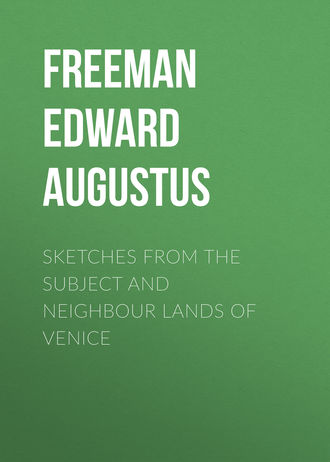 полная версия
полная версияПолная версия
Sketches from the Subject and Neighbour Lands of Venice
Our ecclesiastical traveller who went straight from Trieste to Aquileia in the barouche with the excellent horses made his pilgrimage before the railway was opened. As it is, the more modern inquirer is more likely to take the train to Monfalcone – perhaps humbly, like Saint Jerome, by the third class, perhaps otherwise, according to circumstances. He will pass through a land of specially stony hills coming down near to the sea, but leaving ever and anon, in the most utter contrast, green marshy places between the stones and the water. Some may find an interest in passing by Miramar, the dwelling of the Maximilian who perished in Mexico; some may prefer to speculate about Antenor, and to wonder where he found the nine mouths of Timavus. But it is still possible to go by the same path as our predecessor, and that antiquated course has something to be said for it. The road from Trieste to Aquileia is, for some while at least, not rich in specially striking objects, but it passes over lofty ground whence the traveller will better understand the geography of the Hadriatic, and will come in for some glimpses of the inland parts of this region of many tongues. For here it is not quite enough to say that native Italian and Slave and official German all meet side by side. We are not far off from the march-land of two forms of the Slavonic speech; the tongue of Rome too is represented at no great distance by another of its children, distinct from the more classic speech of Italy. We remember that the Vlach, the Rouman, the Latin-speaking remnant of the East, has settled or has lingered at not very distant points. We are tempted to fancy – wrongly, it may be – that some of them must almost come within the distant landscape. One thing is certain; bearers far more strange of the Roman name, though no speakers of the Roman tongue, are there in special abundance. Those whom sixteenth century Acts of Parliament spoke of as "outlandish persons calling themselves Egyptians," though they certainly now at least no more call themselves Egyptians than Englishmen ever called themselves Saxons, are there as a distinct element in the land. The traveller who comes on the right day may come in for a gipsy fair at Duino; he may hear philologers whose studies have lain that way talking to them in their own branch of the common Aryan tongue. He himself meanwhile, driven to look at their outsides only, perhaps thinks that after all gipsies do not look so very different from other ragged people. Certainly if he chances to be making his way, as it is possible that he may be, from Dalmatia and Montenegro, he will miss, both among the gipsies and the other inhabitants of the land, the picturesque costumes to which he has become used further south. Duino itself, a very small haven, but which once believed that it could rival Trieste, will, to the antiquary at least, be more interesting than its gipsy visitors. A castle on rocks, overhanging the sea – a castle, so to speak, in two parts, one of which contains a tower which claims a Roman date, while the other is said to have sheltered Dante – will reward the traveller who still keeps to the barouche and the horses on his journey to the "church city," instead of making use of the swifter means which modern skill has provided for him.
At last, by whichever road he goes, the traveller finds himself at the little town of Monfalcone, and there he who comes by the railway must now look for the capital barouche and the excellent horses, or such substitutes for them as Monfalcone can supply. A small castle frowns on the hill above the station, but the town contains nothing but an utterly worthless duomo and some street arcades, to remind us once more that, if we are under the political rule of the Apostolic King, we are on soil which is Italian in history and in architecture. After a railway journey which has mainly skirted the sea, perhaps even after a journey over the hills during a great part of which we have looked down on the sea, we are a little surprised at finding that the road which leads us to what once was a great haven takes us wholly inland. We pass through a flat and richly cultivated country, broken here and there by a village with its campanile, till two Corinthian columns catch the eye in front of a modern building, which otherwise might be passed by without notice. Those two columns, standing forsaken, away from their fellows, mark that we have reached Monastero; in the days before Attila we should have reached Aquileia. We are now within the circuit of the ancient colony. But mediæval Aquileia was shut up within far narrower limits; modern Aquileia is shut up within narrower limits still. Within the courtyard of the building which is fronted by the two columns, we find a large collection, a kind of outdoor museum, of scraps of architecture and sculpture, the fragments of the great city that once was. We go on, and gradually our approach to the centre is marked by further fragments of columns lying here and there, as at Rome or Ravenna. A little farther, and we are in modern Aquileia, "città Aquileia," as it still proudly calls itself in the official description, which, as usual, proclaims to the traveller the name of the place where he is, and in what administrative division of the "Imperial and Royal" dominions he finds himself.
Of the village into which the ancient colony has shrunk up we must allow that the main existing interest is ecclesiastical. So far as Aquileia is a city at all, it is now a "church city." The patriarchal church, with its tall but certainly not beautiful campanile, soars above all. But, if it soars above all, it still is not all. Here and there a fragment of a column, or an inscription built into the wall, reminds us of what Aquileia once was. One ingenious man has even built himself an outhouse wholly out of such scraps, here a capital, there a bit of sculpture, there inscriptions of various dates, with letters of the best and of the worst kinds of Roman lettering. Queer and confused as the collection is, the bits out of which it is put together are at least safe, which they would not be if they were left lying about in the streets. Another more regularly assorted collection will be found in the local museum, which has the advantage of containing several plans, showing the extent of the city in earlier times. At last we approach the church, now, and doubtless for many ages past, the one great object in Aquileia. In front of it a single shattered column marks the place of the ancient forum. To climb the tower is the best way of studying the geography of Aquileia, just as to climb the tower of Saint Apollinaris is the best way of studying the geography of Ravenna. In both cases the first feeling that comes upon the mind is that the sea has become a distant object. Now the eye ranges over a wide flat, and the sea, which once brought greatness to Aquileia, is far away. A map of Aquileia in the fifteenth century is to be had, and it is wise to take it to the top of the tower. There we may trace out the churches, gates, and other buildings, which have perished since the date of the map, remembering always that the Aquileia of the fifteenth century was the merest fragment of the vast city of earlier times. A good deal of the town wall of the mediæval date may still be traced. It runs near to the east end of the church, acting, as at Exeter and Chichester, as the wall at once of the town and of the ecclesiastical precinct. The church itself, the patriarchal basilica of Aquileia, is a study indeed, though the first feeling on seeing it either within or without is likely to be one of disappointment. We do not expect outline, strictly so called, in an Italian church; when we come in for any grouping of towers, such as we see at Saint Abbondio at Como and at more wonderful Vercelli, we accept with thankfulness the boon which we had not looked for. So we do not complain that the basilica of Aquileia, with its vast length and its lofty tower, is still, as judged by a northern eye, somewhat shapeless. But in such a place we might have expected to find a front such as those which form the glory of Pisa and Lucca, such a tower as may be found at Pisa and Lucca and at a crowd of places of less renown. We enter the church, and we find ourselves in a vast and stately basilica; but one feature in its architecture at once amazes us. There are the long rows of columns with which we have become familiar at Pisa and Lucca, at Rome and Ravenna; but all the main arches are pointed. And the pointed arches are not, as at Palermo and indeed at Pisa also, trophies of the vanquished Saracen; their details at once show that they are actual mediæval work. We search the history, for which no great book-learning is needed, as inscriptions on the walls and floor supply the most important facts. The church was twice recast, once early in the eleventh century, and again in the fourteenth. The pointed work in the main building is of course due to this last change; the crypt, with its heavy columns and rude capitals, looks like work of the eleventh century, though it has been assigned to the fifth, and though doubtless materials of that date have been used up again. And in the upper church also, the columns of the elder building have, as so often happens, lived through all repairs. Their capitals for the most part are mediæval imitations of classical forms rather than actual relics of the days before Attila. But two among them, one in each transept, still keep shattered Corinthian capitals of the very finest work.
The fittings of the church are largely of Renaissance date, but the patriarchal throne remains, and there are one or two fragments of columns and the like put to new uses. On the north side of the nave is a singular building, known as the sacrario, of which it is not easy to guess the original purpose. It is a round building supporting a miniature colonnade with a conical roof above, so that it looks more like a model of a baptistery than anything else. Those who see Cividale before Aquileia may be reminded of the baptistery within the Templum Maximum. But the Forojulian work is larger than the Aquileian, and we can hardly fancy that this last was really designed to be used for baptism; at all events there is a notable baptistery elsewhere.
In the basilica of Aquileia we have three marked dates, but we may call it on the whole a church of the eleventh century, keeping portions of a church of the fourth, and itself largely recast in the fourteenth. Thus, setting aside later changes, the existing church shows portions of work a thousand years apart, and spans nearly the whole of Aquileian history. When the rich capitals of the transepts were carved, the days of persecution were still of recent memory; when pointed arches were set on the ancient columns, the temporal power of the patriarchate was within a century of its fall. The first church of Aquileia is assigned to the bishop Fortunatian, who succeeded in 347, the last prelate who held Aquileia as a simple bishopric without metropolitan rank. The builder and consecrator of the present church – for present we may call it, though it shows less detail of his work than of either earlier or later times – was Poppo or Wolfgang, patriarch from 1019 to 1042, a man famous in local history as the chief founder of the temporal power of the patriarchate. His influence was great with the Emperors Henry the Second and Conrad the Second; he accompanied the latter prince to his Roman coronation, and must therefore have stood face to face with our own Cnut. The name of this magnificent prelate suggests his namesake, who at the very same moment filled the metropolitan throne of Trier, and was engaged in the same work of transforming a great church of an older day. If we compare Trier and Aquileia, we see how men's minds are worked on by local circumstances and local associations. Poppo of Aquileia and Poppo of Trier were alike German prelates, but one was working in Germany and the other in Italy. The northern Poppo therefore gave the remodelled church of Trier a German character, while the remodelled church of Aquileia remained, under the hands of the southern Poppo, a church thoroughly Italian. We may even say that the essential character of the building was not changed, even by the still later remodelling which brought in the pointed arches; these were the work of Markquard of Randeck, who was translated from Augsburg to the patriarchal see in 1365, and who held it till 1381. He brought in the received constructive form of his day, but he did not by bringing in pointed arches turn the building into Italian Gothic. The church of Markquard remained within and without a true basilica, keeping the general effect of the church of Poppo, perhaps even of the church of Fortunatian. The walls of the church moreover show inscriptions of much later date, recording work done in the church of Aquileia in the days of Apostolic sovereigns of our own time. The newest of all, which was not there in 1875, but which was there in 1881, bears the name of the prince who has ceased to be lord of Forum Julii, but who still remains lord of Aquileia.
But the basilica itself is not all. A succession of buildings join on to the west: first a loggia, then a plain vaulted building, called, but without much likelihood, an older church, which leads to the ruined baptistery. The old map shows this last with a high roof or cupola, and then the range from the western baptistery to the great eastern apse must have been striking indeed. Fragments of every kind, columns, capitals, bits of entablature, lie around; and to the south of the church stand up two great pillars, the object of which it is for some local antiquary to explain. The old map shows that they stood just within the court of the patriarchal palace, which was then a ruin, and which has now utterly vanished. They are not of classical work; they are not columns in the strict sense; they are simply built up of stones, like the pillars of Gloucester or Tewkesbury. Standing side by side, they remind us of the columns which in towns which were subject to Venice commonly bear the badges of the dominion of Saint Mark. But can we look for such badges at Aquileia? The lands of the patriarchate, in by far the greater part of their extent, did indeed pass from the patriarch to the Evangelist. But had the Evangelist ever such a settled possession of the city itself as to make it likely that columns should be set up at Aquileia as well as at Udine? The treaty which confirmed Venice in the possession of the patriarchal state left the patriarchal city to its own bishop and prince. Was the winged lion ever set up, and then taken down again? The old map which represents Aquileia in the fifteenth century shows that, as the pillars carry nothing now, so they carried nothing then. Again, would Venetian taste have allowed such clumsy substitutes for columns as these? And, if they had been meant as badges of dominion, would they not have stood in the forum rather than in the court of the Patriarch's palace?
We are far from having exhausted even the existing antiquities of Aquileia, further still from exhausted its long and varied history. Within the bounds of the fallen city pleasant walks may be taken, which here and there bring us among memories of the past. Here is a fine street pavement brought to light, here a fragment of a theatre. But men do not dig at Aquileia with the same vigour with which they dig at Silchester and at Solunto. The difference between the diggings at the beginning and the end of a term of six years is less than it should be. But we have perhaps done enough to point out the claims of so wonderful a spot on those who look on travelling as something more than a way either of killing time or of conforming to fashion. Aquileia has a character of its own; it is not a ruined or buried city; nor is it altogether like Trier or Ravenna, which, though fallen from their ancient greatness, are cities still. In the general feeling of the spot it has more in common with such a place as Saint David's in our own island, that thorough "church city," where a great minster and its ecclesiastical establishment still live on amid surrounding desolation. But there is no reason to believe that Saint David's, as a town, was ever greater than it is now. Still Saint David's keeps its bishopric, it keeps its chapter; at Aquileia the patriarch with his fifty canons are altogether things of the past. We must seek for their surviving fragments at Udine and Gorizia. Aquileia then, as regards its present state, has really fallen lower than Saint David's. But then at Aquileia we see at every step, what could never at any time have been seen at Saint David's, the signs of the days when it ranked among the great cities of the earth. Aquileia, in short, is unique. We turn away from it with the feeling that we have seen one of the most remarkable spots that Europe can show us. It may be that our horses, excellent or otherwise, take us back to Monfalcone, and that from Monfalcone the train takes us back to Trieste. In theory, it must be remembered, we have not been at Trieste at all; we are going thither from Venice, by way of Treviso, Udine, Gorizia, and Aquileia. In going thither, we shall outstrip the strict boundary of the Lombard Austria, though we shall keep within the Italy of Augustus and the Italy of Charles the Great. On the other hand, in matter of fact it may be that, as we have come by the older mode of going from Trieste to Aquileia, we go on to make our way by the same mode from Aquileia to Gorizia. In favourable states of the astronomical world, we may even be lighted on our way by a newly-risen comet. We follow the precedent of our forefathers: "Isti mirant stellam." Such a phænomenon must, according to all ancient belief, imply the coming of some great shaking among the powers of the world. In such a frame of mind, the gazer may be excused if he dreams that the portent may be sent to show that the boundary which parts Aquileia and Gorizia from Udine and Treviso need not be eternal.
TRIESTE
1875 – 1877 – 1881We have already learned, at Gorizia and at Aquileia, that, whether in real travel or on the map, the subject lands of Venice cannot be kept apart from those neighbour lands which were not her subjects. The Queen of the Hadriatic could at no time boast of the possession of the whole Hadriatic coast; could she now be called up again to her old life, to her old dominion, she would feel very sensibly that she had only a divided rule over her own sea. She would find her peer in a city, a haven, all claim to dominion over which she had formally resigned more than four hundred years before her fall. Facing her from the other side of her own watery kingdom, she would see a city too far off to be an eyesore, but quite near enough to be a rival. She is fronted by a city which hardly comes within the old Venetian land, though it comes within the bounds of the old Italian kingdom, a city which for five hundred years has been parted from Venetian or Italian rule, emphatically a city of the present, which has swallowed up no small share of the wealth and prosperity of the city of the past.
Tergeste, Trieste, stands forth as a rival of Venice, which has, in a low practical view of things, outstripped her. Italian zeal naturally cries for the recovery of a great city, once part of the old Italian kingdom, and whose speech is largely, perhaps chiefly, Italian to this day. But, cry of Italia Irredenta, however far it may go, he must not go so far as this. Trieste, a cosmopolitan city on a Slavonic shore, cannot be called Italian in the same sense as the lands and towns so near Verona which yearn to be as Verona is. Let Trieste be the rival, even the eyesore, of Venice, still Southern Germany must have a mouth. We might indeed be better pleased to see Trieste a free city, the southern fellow of Lübeck, Bremen, and Hamburg; but it must not be forgotten that the Archduke of Austria and Lord of Trieste reigns at Trieste by a far better right than that by which he reigns at Cattaro and Spizza. The present people of Trieste did not choose him, but the people of Trieste five hundred years back did choose the forefather of his great-grandmother. Compared with the grounds on which kingdoms, duchies, counties, and lordships, are commonly held in that neighbourhood, such a claim as this must be allowed to be respectable indeed.
The great haven of Trieste may almost at pleasure be quoted as either confirming or contradicting the rule that it is not in the great commercial cities of Europe that we are to look for the choicest or the most plentiful remains of antiquity. Sometimes the cities themselves are of modern foundation; in other cases the cities themselves, as habitations of men and seats of commerce, are of the hoariest antiquity, but the remains of their early days have perished through their very prosperity. Massalia, with her long history, with her double wreath of freedom, the city which withstood Cæsar and which withstood Charles of Anjou, is bare of monuments of her early days. She has been the victim of her abiding good fortune. We can look down from the height on the Phôkaian harbour; but for actual memorials of the men who fled from the Persian, of the men who defied the Roman and the Angevin, we might look as well at Liverpool or at Havre. Genoa, Venice herself, are hardly real exceptions; they were indeed commercial cities, but they were ruling cities also, and, as ruling cities, they reared monuments which could hardly pass away. What are we to say to the modern rival of Venice, the upstart rebel, one is tempted to say, against the supremacy of the Hadriatic Queen? Trieste, at the head of her gulf, with the hills looking down to her haven, with the snowy mountains which seem to guard the approach from the other side of her inland sea, with her harbour full of the ships of every nation, her streets echoing with every tongue, is she to be reckoned as an example of the rule or an exception to it?
No city at first sight seems more thoroughly modern; old town and new, wide streets and narrow, we search them in vain for any of those vestiges of past times which in some cities meet us at every step. Compare Trieste with Ancona; we miss the arch of Trajan on the haven; we miss the cupola of Saint Cyriacus soaring in triumph above the triumphal monument of the heathen. We pass through the stately streets of the newer town, we thread the steep ascents which lead us to the older town above, and we nowhere light on any of those little scraps of ornamental architecture, a window, a doorway, a column, which meet us at every step in so many of the cities of Italy. Yet the monumental wealth of Trieste is all but equal to the monumental wealth of Ancona. At Ancona we have the cathedral church and the triumphal arch; so we have at Trieste; though at Trieste we have nothing to set against the grand front of the lower and smaller church of Ancona. But at Ancona arch and duomo both stand out before all eyes; at Trieste both have to be looked for. The church of Saint Justus at Trieste crowns the hill as well as the church of Saint Cyriacus at Ancona; but it does not in the same way proclaim its presence. The castle, with its ugly modern fortifications, rises again above the church; and the duomo of Trieste, with its shapeless outline and its low, heavy, unsightly campanile, does not catch the eyes like the Greek cross and cupola of Ancona. Again at Trieste the arch could never, in its best days, have been a rival to the arch at Ancona; and now either we have to hunt it out by an effort, or else it comes upon us suddenly, standing, as it does, at the head of a mean street on the ascent to the upper town. Of a truth it cannot compete with Ancona or with Rimini, with Orange or with Aosta. But the duomo, utterly unsightly as it is in a general view, puts on quite a new character when we first see the remains of pagan times imprisoned in the lower stage of the heavy campanile, still more so when we take our first glance of its wonderful interior. At the first glimpse we see that here there is a mystery to be unravelled; and as we gradually find the clue to the marvellous changes which it has undergone, we feel that outside show is not everything, and that, in point both of antiquity and of interest, though not of actual beauty, the double basilica of Trieste may claim no mean place among buildings of its own type. Even after the glories of Rome and Ravenna, the Tergestine church may be studied with no small pleasure and profit, as an example of a kind of transformation of which neither Rome nor Ravenna can supply another example.









